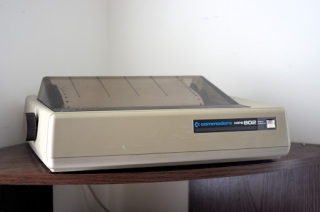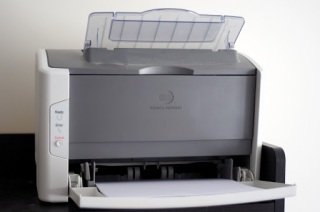I’ve used many different types of printers over the years. My first printer was a Commodore dot matrix printer, which used a relatively expensive carbon ribbon. I later opted for an Epson 9 pin dot matrix, which utilized the more economical fabric ribbon. Inkjet and bubble jet printers introduced in the mid 1980’s became affordable in the early 1990’s, and promised laser-like quality, but I was rightly skeptical of the cost of ink as the cost of the printers was deferred by greater profits made from ink sales, and so I stuck with my trusty dot matrix. Eventually, I did buy an Epson inkjet printer, and suffered the shock of ink prices costing more than my printer. I discovered the Canon S300 was a reasonable and affordable alternative that paid for itself after replacing the ink on the Epson twice, but decided to defer that expense further with a Konica Minolta Pagepro 1400 monochrome laser printer for non-colour printing.
 |
| My first printer: Commodore MPS 802 |
The time has come for me to re-evaluate my printing needs. The cost of toner for my laser printer has gone up over the years and, given that the printer has been discontinued, has become increasingly difficult to find. I just discovered that this is the last time I can refill the toner cartridges I bought with the printer. A new toner cartridge costs around $70, and yields 2000 pages, for a cost of 3.5 cents per page. I can get a black ink cartridge for my Canon inkjet for around $10, but with a yield of 150 pages, it’s costing me 6.7 cents per page. The colour ink, at around $25, yields 160 pages, for an expense of 15.6 cents per page. I could try my luck with refills, but considering the age of my printers, I reasoned it was time to start shopping for a new one to see if the market had improved.
The case for the all-in-one
 |
| My trusty, crusty Canon S300 |
For years, I avoided the all-in-one printers. I was concerned that, if one device broke, I could still use the other devices. Nothing ever broke. Businesses from small to large, presumably ran by very frugal individuals sitting in front of spreadsheets, tended to favour the all-in-one solutions. After careful consideration, I understood why: The all-in-ones offer time-saving conveniences that stand-alone units don’t, in addition to cost savings. For example, the scanners will usually have a feeder allowing one to scan in multiple pages at a time, without requiring one to manually change the pages and hit the “Scan” button again and again – a big time-saver. It’s often the case that scanned documents need to be faxed, and the all-in-one provides a one-stop time-saving solution for this without needing computer use. With wireless capability, the fax, printer, and scanning features can be shared with everyone in my household with a minimal amount of effort. Buying a scanner and printer separately generally costs more. Finally, going back to my original reasoning, if my computer broke, I could still send and receive faxes as well as make copies. There is also the fact that those models oriented towards businesses typically have automatic duplex capability – the ability to print on two sides of a page at a time – saving on paper and resulting in a more professional-looking result. All-in-one’s really do provide an economical solution with significantly greater convenience. What’s good for business is good for me.
The modern cost of laser
 |
| A reliable, reasonably cost-efficient, personal laser printer |
The Samsung CLX-3305FW colour multifunction seems a remarkable deal, currently on sale for around $180. A black toner cartridge for this printer costs $75, and yields 1,500 pages, for a cost of 5 cents per page! Each colour toner cartridge costs $75 each, and yields 1,000 pages, for a cost of 22.5 cents per page. This is heading into inkjet territory. The HP LaserJet Pro M1212nf, a monochrome laser all-in-one priced at around $130, has toner cartridges that cost around $95 each and yield 1200 pages each, for a cost of 7.9 cents per page. What’s happening here? It appears as though the laser manufacturers have borrowed a page from the low-cost ink jet printer makers: Sell the laser printers at extremely low prices, and make huge profits from the consumables (toner).
The case for ink jets
All-in-one inkjets are delivering competitive products to the business market, with business-oriented names like Epson Workforce and HP OfficeJet. Priced competitively but not ridiculously cheap, the consumables for these printers are on par with, or sometimes better than, competing laser printers. They also add the convenience of being able to produce colour photographs.
The all-in-one inkjet I opted for was the HP 6500a plus. A high yield black ink cartridge costs around $40 and yields up to 1200 pages, for a cost of 3.3 cents per page, squeezing out my laser printer. Each of the three high yield colour ink cartridges costs $20 and yield up to 700 pages, for a cost of 8.6 cents per page.
 |
| My new all-in-one HP OfficeJet |
That’s just the tip of the cost-saving iceberg. Just like I did with my laser printer, I can obtain “Refilled” ink cartridges for my HP printer. The objective for moving towards an office all-in-one was to gain access to the low cost-per-page ink costs promised and delivered by HP, but I’ve seen the high yield black for $15 (1.25 cents per page), and high yield colour for $10 each (4.3 cents per page) which drives the cost per page down even lower. That beats a refilled toner cartridge for my laser printer by approximately 75 cents per page. Whether or not these re-manufactured ink cartridges work well is often a topic for debate, but of the people I know who have used re-manufactured ink cartridges, I haven’t heard any complaints.
Conclusion
It’s no surprise to me that an ink jet can be cheaper to buy and own than a laser printer. In fact, the only thing that made laser printers seem so lucrative was the fact that ink jet manufacturers charged excessively high amounts for proprietary ink cartridges, and went to great lengths to prevent the use of refilled ink cartridges. By all rights, ink jet printers should cost less than laser printers; the amount and type of materials used for the build of each printer type calls for it. Also, besides the artificial profit margins generated by certain printer models and vendors, there’s nothing to justify ink costing more than toner. In fact, it should, and generally does, cost less. The newspaper industry knows this full well, which is why, even today, newspapers come from a machine that uses ink, not toner, to produce their mass quantities.
It’s nice to see the cost of inkjet printing technology finally coming down to reality. My advice would be to stick with products marketed towards business, and do the math on the price of replacement ink. Most of all, avoid the cheap printers that have overpriced ink or toner cartridges. It looks like inkjet technology has a future for the frugal minded.





